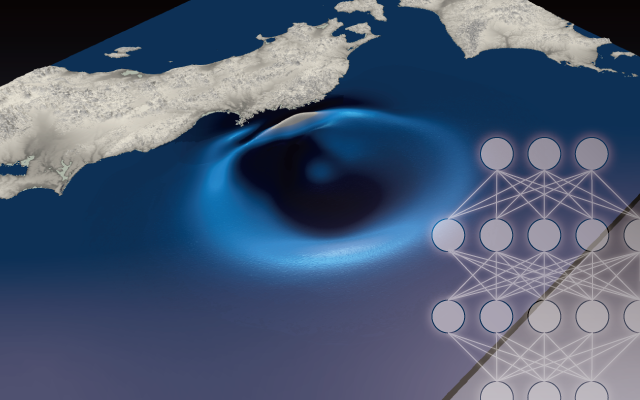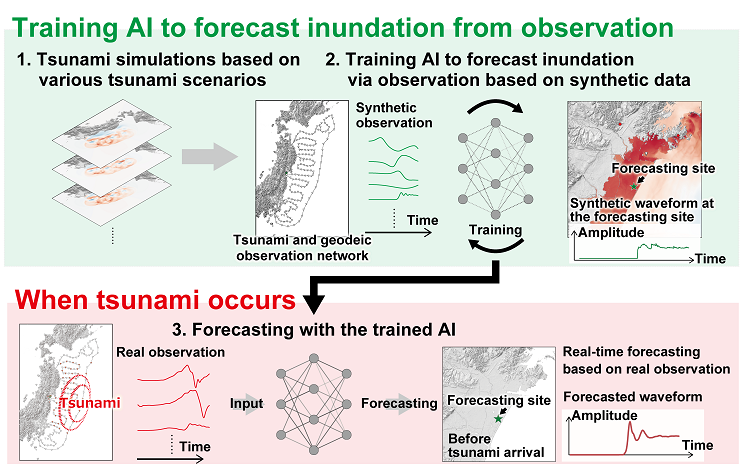Real-Time Tsunami Inundation Forecasting – Leveraging AI
The paper regarding the AI-enabled tsunami forecasting was published in Nature Communications
June 1, 2021
JapaneseIn recent years, social expectations for leveraging ICT for disaster risk reduction applications are increasing, especially as we experience more frequent and intense natural hazards. Fujitsu Research has been developing a number of technologies for tsunami disaster risk reduction, utilizing cutting-edge ICT such as supercomputers and AI, collaborating with the International Research Institute of Disaster Science at Tohoku University, and the Earthquake Research Institute at The University of Tokyo. In this collaborative research project, we have successfully developed a real-time tsunami inundation forecasting method utilizing AI, which has been demonstrating remarkable performance in image recognition and other broader applications in recent years. The jointly developed forecasting approach has the potential to deliver fast and detailed tsunami inundation forecasting, even with small computational facilities such as a personal home computer. This technology was developed in collaboration with Professor Fumihiko Imamura at the International Research Institute of Disaster Science at Tohoku University and Professor Takashi Furumura at the Earthquake Research Institute at The University of Tokyo. A paper detailing this AI-enabled tsunami forecasting was published in Nature Communications on April 15, 2021.

Overview of the paper
・Journal: Nature Communications
・Publication Dates: April 15, 2021
・Title: Early Forecasting of Tsunami Inundation from Tsunami and Geodetic Observation Data with Convolutional Neural Networks
・Authors: Fumiyasu Makinoshima (Fujitsu Ltd.), Yusuke Oishi (Fujitsu Ltd.), Takashi Yamazaki (Fujitsu Ltd.), Takashi Furumura (The Earthquake Research Institute, The University of Tokyo), Fumihiko Imamura (The International Research Institute of Disaster Science, Tohoku University)
・Link: https://www.nature.com/articles/s41467-021-22348-0![]()
A Detailed insight into the Technology
Rapid and detailed tsunami inundation forecasting, particularly during the lead time between the generation of the tsunami and its arrival at coastal communities, can provide important information to support quick and appropriate evacuation behavior in coastal communities. In the decade since the 2011 Tohoku tsunami, offshore and coastal tsunami observation networks and methods for real-time tsunami forecasting using observation data have been enhanced, based on lessons learned from past tsunami experiences. After estimating the tsunami source immediately after the earthquake, previous real-time tsunami inundation forecasting methods generally involve a huge computational cost for a real-time tsunami simulation, using super computers to provide a detailed tsunami inundation forecast at specific onshore locations. The newly developed approach utilizes AI, which has been pre-trained on large amounts of synthetic tsunami simulations, enabling it to predict a tsunami inundation waveform at a forecasting site from various observation data.
When an earthquake occurs, the trained AI rapidly provides a tsunami inundation waveform that includes both information regarding the tsunami height and the arrival time based on real-time observation data (See Figure 1 for a schematic view of the forecasting method).
 Figure 1 detailing a schematic view of the forecasting method
Figure 1 detailing a schematic view of the forecasting method
The trained AI can generate a forecast extremely quickly even when using a personal computer. As a result, the newly developed method offers a great advantage for practical disaster management in terms of the required computational resources. Using the actual observation data from the 2011 Tohoku tsunami event as inputs, we verified the forecasting performance of the AI trained on 10,000 synthetic tsunami scenarios against the actual tsunami traces observed in the 2011 event.
The results showed that the trained AI could provide fast and reasonable inundation forecasting that suggested an evacuation requirement approximately 34 minutes before the arrival of the large tsunami at the forecasted site. With the AI trained on various synthetic tsunami simulations in advance, the newly developed forecasting approach has the potential to provide reasonable tsunami forecasting even for types of tsunami that we have never experienced before.
Through industry-academia collaborative research projects, Fujitsu Research is promoting research and development to contribute to realize a safe and reliable society in the future.
Related Links
・Fujitsu Leverages World’s Fastest Supercomputer ‘Fugaku’ and AI to Deliver Real-Time Tsunami Prediction in Joint Project[Fujitsu Global Site]![]() (February 16, 2021 Press Releases)
(February 16, 2021 Press Releases)
Inquiries regarding this matter
contact-tsunami@cs.jp.fujitsu.com
Please note that we would like to ask the people who reside in EEA (European Economic Area) to contact us at the following address.
Ask Fujitsu
Tel: +44-12-3579-7711
http://www.fujitsu.com/uk/contact/index.html![]()
Fujitsu, London Office
Address :22 Baker Street
London United Kingdom
W1U 3BW



